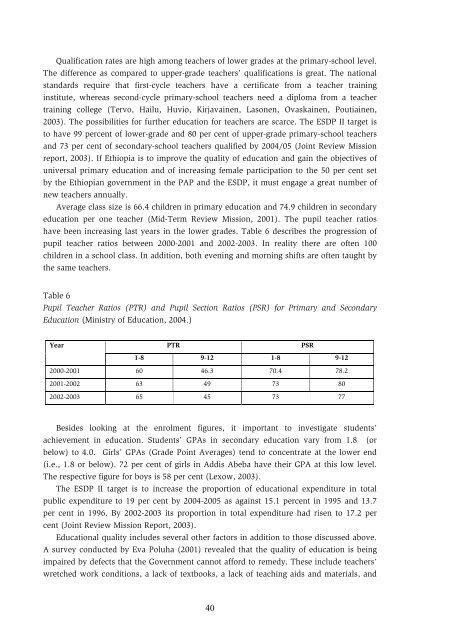Education and Training in Ethiopia An Evaluation of Approaching EFA Goals
Education and Training in Ethiopia - Koulutuksen tutkimuslaitos
Education and Training in Ethiopia - Koulutuksen tutkimuslaitos
- No tags were found...
Create successful ePaper yourself
Turn your PDF publications into a flip-book with our unique Google optimized e-Paper software.
Qualification rates are high among teachers <strong>of</strong> lower grades at the primary-school level.The difference as compared to upper-grade teachers’ qualifications is great. The nationalst<strong>and</strong>ards require that first-cycle teachers have a certificate from a teacher tra<strong>in</strong><strong>in</strong>g<strong>in</strong>stitute, whereas second-cycle primary-school teachers need a diploma from a teachertra<strong>in</strong><strong>in</strong>g college (Tervo, Hailu, Huvio, Kirjava<strong>in</strong>en, Lasonen, Ovaska<strong>in</strong>en, Poutia<strong>in</strong>en,2003). The possibilities for further education for teachers are scarce. The ESDP II target isto have 99 percent <strong>of</strong> lower-grade <strong>and</strong> 80 per cent <strong>of</strong> upper-grade primary-school teachers<strong>and</strong> 73 per cent <strong>of</strong> secondary-school teachers qualified by 2004/05 (Jo<strong>in</strong>t Review Missionreport, 2003). If <strong>Ethiopia</strong> is to improve the quality <strong>of</strong> education <strong>and</strong> ga<strong>in</strong> the objectives <strong>of</strong>universal primary education <strong>and</strong> <strong>of</strong> <strong>in</strong>creas<strong>in</strong>g female participation to the 50 per cent setby the <strong>Ethiopia</strong>n government <strong>in</strong> the PAP <strong>and</strong> the ESDP, it must engage a great number <strong>of</strong>new teachers annually.Average class size is 66.4 children <strong>in</strong> primary education <strong>and</strong> 74.9 children <strong>in</strong> secondaryeducation per one teacher (Mid-Term Review Mission, 2001). The pupil teacher ratioshave been <strong>in</strong>creas<strong>in</strong>g last years <strong>in</strong> the lower grades. Table 6 describes the progression <strong>of</strong>pupil teacher ratios between 2000-2001 <strong>and</strong> 2002-2003. In reality there are <strong>of</strong>ten 100children <strong>in</strong> a school class. In addition, both even<strong>in</strong>g <strong>and</strong> morn<strong>in</strong>g shifts are <strong>of</strong>ten taught bythe same teachers.Table 6Pupil Teacher Ratios (PTR) <strong>and</strong> Pupil Section Ratios (PSR) for Primary <strong>and</strong> Secondary<strong>Education</strong> (M<strong>in</strong>istry <strong>of</strong> <strong>Education</strong>, 2004.)YearPTRPSR1-8 9-12 1-8 9-122000-2001 60 46.3 70.4 78.22001-2002 63 49 73 802002-2003 65 45 73 77Besides look<strong>in</strong>g at the enrolment figures, it important to <strong>in</strong>vestigate students’achievement <strong>in</strong> education. Students’ GPAs <strong>in</strong> secondary education vary from 1.8 (orbelow) to 4.0. Girls’ GPAs (Grade Po<strong>in</strong>t Averages) tend to concentrate at the lower end(i.e., 1.8 or below). 72 per cent <strong>of</strong> girls <strong>in</strong> Addis Abeba have their GPA at this low level.The respective figure for boys is 58 per cent (Lexow, 2003).The ESDP II target is to <strong>in</strong>crease the proportion <strong>of</strong> educational expenditure <strong>in</strong> totalpublic expenditure to 19 per cent by 2004-2005 as aga<strong>in</strong>st 15.1 percent <strong>in</strong> 1995 <strong>and</strong> 13.7per cent <strong>in</strong> 1996. By 2002-2003 its proportion <strong>in</strong> total expenditure had risen to 17.2 percent (Jo<strong>in</strong>t Review Mission Report, 2003).<strong>Education</strong>al quality <strong>in</strong>cludes several other factors <strong>in</strong> addition to those discussed above.A survey conducted by Eva Poluha (2001) revealed that the quality <strong>of</strong> education is be<strong>in</strong>gimpaired by defects that the Government cannot afford to remedy. These <strong>in</strong>clude teachers’wretched work conditions, a lack <strong>of</strong> textbooks, a lack <strong>of</strong> teach<strong>in</strong>g aids <strong>and</strong> materials, <strong>and</strong>40




![to read the full report [pdf, Amharic] - Ethiopian Review](https://img.yumpu.com/52737829/1/190x245/to-read-the-full-report-pdf-amharic-ethiopian-review.jpg?quality=85)











